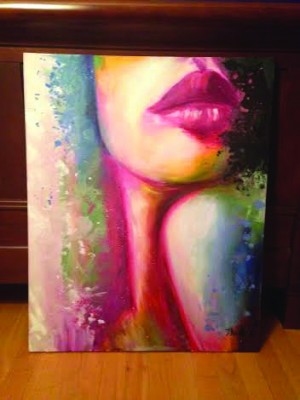The art of color
 Colors tell us how to feel and what to think. Colors symbolize life and love, fear and danger. But sometimes black and white can tell a story more thoroughly and create a mood quite opposite of what color does. Black and white freeze time and can exaggerate an idea.
Colors tell us how to feel and what to think. Colors symbolize life and love, fear and danger. But sometimes black and white can tell a story more thoroughly and create a mood quite opposite of what color does. Black and white freeze time and can exaggerate an idea.
Artists face tough choices: work in color or black and white?
Using color for artists creates an emphasis on the idea that is being conveyed.
“Artists would use color in art to symbolize something else, I think to reinforce an idea, to set a mood, and create some expression,” Kristen LaJeunesse, art teacher, said. “I think student artists gravitate towards color.”
Theodora Pavlou, senior, uses color in her art to make it stand out more and to express her inner emotions.
“[Art] makes me feel better, and I love to work with colors,” Pavlou said. “If I’m stressed out I’ll paint.”
The colors, according to Pavlou express her mood. When she is happy or bored she will paint sunsets or flowers.
To find new forms of expression, Pavlou mixes colors together to create something completely unique.
“I love mixing colors together, and making cool [colors],” Pavlou said. “[Colors] make the painting come together.”
Different art medias to help pinpoint whether a student would or would not use color in their art pieces.
“When the students are working in painting [they are] working with color. In drawing certain media would be colored based, so I would say that class would be [half color, half black and white]” LaJeunesse said. “In ceramics and sculpture you’re adding color to match [what] you’re creating.”
Black and white images take on a different tone and meaning than a color piece would. Black and white can help show time period, place, or memory.
“I think we as artists or citizens in this community have an association with black and white,” LaJeunesse said. “It gives an [impression] of a time period.”
LaJeunesse gravitates towards black and white because she finds it to have a more vintage look.
“There is something very classic about a black and white image whether it’s a photograph or it’s a painting, it imbues this idea of a memory or a historical setting,” LaJeunesse said. “Even though it could be something highly digital.”
The use of black and white is common with senior student photographer, Kasia Konsor. Konsor photographs black and white images along with color from time to time. However she prefers to use black and white.
“Because of black and white you’re not so much focused on the hues (a gradation or variety of a color, according to Dictionary.com), you’re focused on the composition of the photo and a lot of different things can pop out where color could interfere,” Konsor, said.
While color can bring a certain character to art, Konsor uses black and white images for a more dramatic approach to create a particular mood in the image.
“I tend to gravitate towards black and white,” Konsor said. “The mood can be more dramatic and it’s sometimes more interesting to look at.”
Artists use their projects to identify an idea that they want to give to their viewers; specifc colors and images create this idea and mood.
“There’s a different mood, there’s a different message that black and white sends that [color can’t],” Lajeunesse said. “It’s really about the viewer looking at the work and extracting info based on the colors or lack of.”
